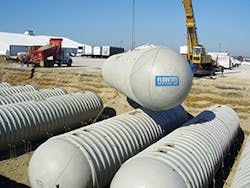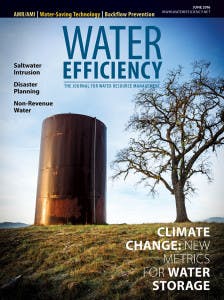Editor’s note: This article first appeared in the June 2016 issue of Water Efficiency.
Fire flow needs and regulations have always dominated the metrics for sizing the water storage capacity of a municipality or business.
But these days, climate change, drought, and population growth have entered the picture as additional factors requiring consideration.
Those factors have a dramatic, albeit complex role to play into the metrics for sizing water capacity, says Kai Langendoen, president of Water Storage Tanks Inc., which manufactures corrugated galvanized steel tanks and wood tanks for rainwater harvesting, fire protection, stormwater management, and potable drinking water.
“Climate change has introduced more severe weather patterns,” he points out. “We see long periods of harsh drought followed by torrential rains in some parts of the country. Historical weather patterns are not holding true, which makes planning near impossible. To exacerbate the problem, there is a migration of people to parts of the country that are lacking in water.”
Langendoen cites as an example his hometown of Austin, TX, one of the country’s fastest-growing areas.
“The population boom is straining the rivers and the aquifers,” he says. “In some parts of Texas, they are managing the groundwater so that they can be assured it will last 50 years, but they know the aquifer will be depleted in that time. Fifty years isn’t very long beforethey go dry.
“We have more people consuming a finite resource. And with population growth comes more impervious coverage, so when we do get rain, it causes flooding and damage, but it doesn’t permeate into the ground. It rushes into the rivers, overwhelms the dams and reservoirs, and is not captured for future use.”
In response to the ongoing historic drought that has impacted the region, the Austin City Council created the Austin Water Resource Planning Task Force.
The task force examined alternative water sources such as conservation, reuse, regional transmission systems and partnerships, groundwater, and aquifer storage, as well as other potential sources in the region.
The group’s foremost recommendation was to create the Integrated Water Resource Planning Community Task Force to participate in the development of the Integrated Water Resource Plan, identifying and facilitating opportunities for regional partnerships, technology cost sharing, balanced regional water reliability, and improved drought preparedness.
Flowtite water storage tanks
Peter Young, vice president of Flowtite water products for Containment Solutions Inc., says his company notes a significant trend in that the average size of tanks it provides is getting larger and increasing in diameter.
While Containment Solutions’ fiberglass tanks were originally designed for the safe storage of petroleum and other combustible materials, the tanks began being used in the water industry with the introduction of the Flowtite line of water storage tanks.
Flowtite water storage tanks are designed to meet AWWA D120, NFPA 22, NSF 61, and International Association of Plumbing and Mechanical Officials standards for water and wastewater storage tanks. Underground fiberglass water storage tanks can contribute tosatisfying multiple credits of the LEED green building rating system.
The company’s tanks are used in five major water markets primarily in the commercial sector: potable water, onsite septic treatment, rainwater harvesting, fire protection, and surface water runoff.
Twenty years ago, 90% of the tanks the company built were 8 feet in diameter and now 90% of them are 10 feet in diameter. Ten years ago, the company manufactured a lot of 15,000- to 20,000-gallon tanks, he says, adding that it is now common to get orders for 30,000- to 50,000-gallon tanks.
Economics is the driving factor, says Young.
“It’s not that much more expensive to go larger,” he points out. “If you’re excavating or building a building, you start to look at the difference between 20,000 gallons and 30,000 gallons and the incremental cost. The cost per gallon on fiberglass goes down as the tanks get larger and the incremental cost to install that capacity is lower.”
Factors such as the impact of drought on sizing water tanks are specific to geographic regions, says Young, pointing out that California regulations, for example, require retention onsite rather than permitting runoff from the site.
There also is the matter of population growth and long-term supply.
“It’s not so much the finished water storage as it is the availability of a source water supply,” says Steve Via, regulatory affairs manager for the American Water Works Association (AWWA). The first point to look at is increasing conservation, managing water loss more effectively, identifying alternative supplies, interconnects, recycling, and more substantial consideration of direct potable reuse.”
Via says there’s a greater move toward encouraging recycling within facilities or diverting wastewater into reuse scenarios such as irrigation to reduce the demand for finished water.
“It’s making a more robust supply rather than re-thinking the matching up of distributed water,” he adds. “When it gets into the demand side, conservation is going to have as much of an effect as other factors on the storage inside of the distribution system.”
Depending on the city and habits of its inhabitants, 60–80% of its municipal supply could be used for nonpotable uses, says Langendoen.
“Yet the city must assume that 100% is being used for potable,” he adds. “That puts a strain on city planners and water resource professionals. So the discussion really needs to be tailored to how do we preserve the traditional municipal supply for potable needs and supplement the supply for nonpotable needs?”
City planners should consider alternative water sources such as rainwater and implement codes that require proper infrastructure be built to meet long-term demands, says Langendoen.
Case in point: Tucson, AZ. There, city officials have required that all new buildings have dual plumbing lines: one set for potable water and one set for graywater.
While city officials did not go far enough by defining how those lines should be used, “it is a step in the right direction,” says Langendoen. “At least those buildings now have a means to use rainwater without risk of contaminating the municipal supply should a harvesting system be installed.”
Langendoen says if each municipality “took a few progressive steps toward conservation and supplementation, we wouldn’t be as worried about water restrictions and drought conditions. Rainwater harvesting is just one of those steps, but it would go a long way.”
Young concurs that the industry is evolving toward an increased use of treatment systems for rainwater that can then be used for such applications as irrigation, so as to not utilize potable water for such purposes.
“The systems are becoming more sophisticated where that type of water and even water runoff from impervious surfaces on a site can then be post-treated with ultraviolet or filters,” says Young. “In that case, the standard is generally that all of the components have to meet NSF/ANSI 61 Drinking Water Components.”
Young says he believes water conservation hardware technologies have essentially “maxed out” with the availability of low-flow toilets and other fixtures. He sees major changes, however, in the storage and reuse of graywater, a trend he believes will create a “major change” in the next decade.
“For example, 95% of the water people use gets flushed and goes into a treatment system or in the municipal sewers,” he says. “We’re seeing the treatment systems out there where that water can be reused not necessarily as drinking water, but graywater.
“The technology exists to take graywater and make it drinking water quality, but I think psychologically, it’s going to be a stretch for most people to accept the fact that at one time this water was graywater and now they’re going to take a shower with it.”
Water quality is a significant consideration in water storage capacity, says Via.
Via notes that while there hasn’t been a substantial change in fire flow as the driving factor in sizing water capacity, “now we’re interested in water quality within the constraints of maintaining fire flow and adequate pressure across the different pressure zones.
“Distribution system managers are trying to minimize water age and design tanks so they end up with high-quality water entering and leaving the tanks. Managing the water in the distribution system so you don’t end up with situations like nitrification episodes is all a part of achieving those goals.”
Via says that over the course of the last five years, large water utilities have been rethinking their distribution systems and how effectively they’re moving water around them.
“Some systems have been taking finished water reservoirs offline and rethinking their pressure zone so they could keep the water age down and also meet fire flow demands,” he says.
There’s an inherent constraint in working within existing tankage, he adds.
“Water systems see more and more conservation either in industrial manufacturing facilities using less water directly in process use or recycling water inside of facilities,” says Via. “You’re going to see systems trying to do a better job of managing that water quality versus quantity for fire flow. That’s going to be a point that’s going to require some work in the future.”
Via points out that in places such as California where demand is decreasing because of restrictions or water is being managed to respond to the drought, “the need to move that water and keep it fresh—not letting the overall age of the water get too high—is something that still has to be done.”
That not only applies to municipal water providers, but to businesses for which water storage security is a concern, points out Via.
“There are some businesses that—because of concerns about security and the ability to maintain operations for several days—have been incorporating larger quantities of storage on site into their facility designs,” he says.
Facilities that opt to do that out of a concern that it’s critical to sustain their operations need to be “very careful” about managing water quality over time, points out Via.
“If they don’t have a demand on that water, it’s simply a storage reservoir sitting there. There are going to be effects on water quality over time,” he adds. “That could be important to how that water is used once it’s drawn on.”
Water storage incorporated into building design
Mission critical facilities such as hospitals will use tanks as backup water storage, notes Young.
Another example of sites with potable water tanks to back up a source of water that is insufficient for peak usage are campsites and parks, says Young.
“They may pump out of the wells at night and fill up a storage tank and have capacity to meet their peak demands,” he points out.
In sizing tanks, in addition to adhering to regulations, “they’ve got to look at their needs either for an emergency or for just normal consumption,” says Young. “They need to look at conservation.”
In sizing tanks for water storage, daily usage numbers for regular and emergency usage must be established, as well as determining options for available water, points out Young.
In the case of a water tank at a hospital, for instance, “what type of elective procedures could they curtail in the event of an emergency?” points out Young. “They could look at how they might shut down parts of a hospital to reduce water usage during an emergency.”
Business owners have even more to consider when looking at their water resources, says Langendoen.
“Not only do they need to ensure they have enough supply for potable, graywater, and irrigation needs, but they must also consider fire protection,” he points out. “Fire protection requirements are evolving and many cities require new businesses to provide adequate fire flow in order to receive their building permits.”
Water storage tanks are an acceptable solution for businesses that have inadequate municipal supply to meet flow requirements, he adds.
“A fire marshal or engineer will determine—based on the size of the building and its inhabitants—how much water is needed and it will be the responsibility of the business owner to ensure those requirements are met and to code,” says Langendoen.
A rule of thumb: the fire response team must be able to access 1,000–1,500 gallons of water per minute for a sustainable 60 minutes for most small businesses.
“It may be more gallons and longer for larger buildings,” says Langendoen. “The fire marshal will ultimately dictate. So it is actually common to see a business putting in a 60,000-gallon tank in order to get its building permits.”
Once used only for potable water, tanks are increasingly being used for stormwater management.
“We recently installed a series of tanks in a small courtyard to control the runoff from the surrounding apartment building,” he says. “The more we can store, even if just used for irrigation, the better off the community as a whole will be.”
Langendoen calls it “shameful” to drive around an urban or suburban area with significant impervious coverage and no water capture plan.
“If each building owner took responsibility for their own site and strove to meet a zero runoff standard, we’d see much less flood devastation and wouldn’t hear about so many water restrictions being implemented,” he adds.
Drought and subsequent wildfires raise national awareness of the issues, points out Langendoen.
“A good example of climate change and how drought has created awareness is the Bastrop, Texas, fire of September 2011,” he says. “Due to drought conditions and a quick change in the weather pattern that created strong winds, the traditional water supply could not keep up with the needs for fire protection for the growing population of Bastrop.”
As a result, 34,068 acres burned and approximately 1,650 homes were completely lost or destroyed.
“This single event drew national attention and created awareness of how limited our resources are and how a drought can have a dramatic impact,” says Langendoen. “Unfortunately, it takes a large catastrophic event to influence the public and regulators alike to prepare for the future.”You may need to log-in or subscribe to our magazine.







